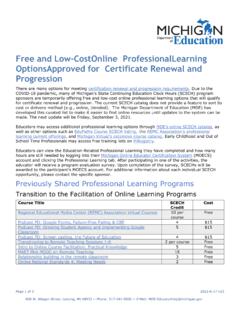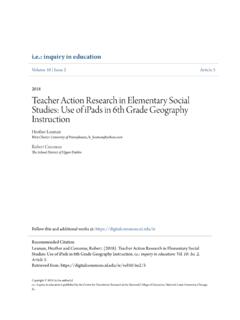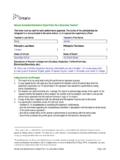Transcription of School-Centered Interventions: Evidence-Based Strategies ...
1 3 Interventions: Evidence-Based Strategies for social , Emotional, and Academic Success, by D. J. SimonCopyright 2016 by the American Psychological Association. All rights family, schools function as the center of children s lives. Family and community identities and activities emanate from local elementary and secondary schools. These educational institutions are the center of service delivery to children and adolescents not only for academic instruction but also for extracurricular activities and a large range of community services. Community organizations and special events often convene within the school setting. Public schools remain one of the few mandated service provid-ers for youth. Within the context of special education requirements, schools provide mental health services to children and adolescents even when other agencies or private practitioners may deflect or limit a focal point in the lives of children, adolescents, and their families, schools can be the optimal setting for the provision of psychotherapy for youth.
2 School psychologists, social workers, and counselors observe, assess, interact, and intervene with students within their natural work and social Copyright American Psychological Association4 School-Centered INTERVENTIONS environments where issues and problems commonly emerge. They may fol-low students and work with families periodically over the course of many years. Mental health service providers in community supported clinics and private service delivery settings must work closely with schools to understand the character and manifestation of the child or adolescent s psychological symptoms. Then, they must collaborate closely with school staff for problem solving and intervention planning, integrating aspects of treatment into the school central assumption of this text is that School-Centered therapy is the most effective format for addressing social , emotional, and behavioral issues for children and adolescents.
3 Therapeutic interventions are more likely to benefit students when Strategies are integrated across individual, family, and school there are challenges to integrating such programs in schools. Although there is a growing recognition of the link between academic suc-cess and mental health, schools struggle to develop effective Strategies to integrate services. There has been limited guidance provided for the adapta-tion of empirically supported clinical Strategies to the school context. Too often, therapy is conceived as an isolated task with minimal attention paid to educational interventions or influencing the social contexts in which prob-lems occur. Insufficient frameworks exist for therapists outside the school setting to collaborate with educators and implement interventions to address functioning at school. This text will provide Strategies to address these a former director of a zero-reject public therapeutic day school in a large metropolitan area, I have been privileged to work with diverse students who have experienced the most severe impairments from psychological dis-orders.
4 Our staff collaborated with multiple partners working both within and outside of the school setting chief among them teachers, other educators, parents, and youth to design and implement therapeutic interventions for children experiencing internalizing and externalizing disorders. The same integrated approach proved effective in work in standard school on this extensive personal experience designing and provid-ing therapeutic services within elementary and secondary schools, I present in this book a practical framework for delivering Evidence-Based interven-tions (EBIs) in schools. I suggest how to both select interventions and make appropriate adaptations for the school context. The text covers interventions in both standard and special education programs, and it advocates for a com-prehensive multitiered this book, I cover the major symptom patterns affecting youth, pro-vide practical examples of intervention Strategies , and point the reader to specific empirically supported protocols.
5 It is beyond the scope of this text to describe each intervention component in complete detail; rather, I provide Copyright American Psychological AssociationINTRODUCTION 5broad descriptions, focusing on how these interventions interface with the school context and what this means for implementation. My overall goal is to help bridge the gap between research and applied settings. This book is appropriate for school psychologists, social workers, and counselors and for clinical psychologists and other community mental health practitioners who work closely with schools to treat the psychological issues faced by the chil-dren and families they serve. Classroom teachers will benefit from each sec-tion s description of instructional use case examples to illustrate case conceptualization and interven-tion protocols, drawn from my own direct clinical experience as well as that of my colleagues.
6 To protect client confidentiality, cases have been blended or address interventions for both children and adolescents. When there are developmental differences that must be addressed regarding assessment and intervention, I have made distinctions between the two groups. When a concept applies across developmental levels, I refer to children and adolescents. At times, however, for economy of expression, I use the terms children and youth to refer to students at all age remainder of this chapter provides essential background concep-tual information about Evidence-Based interventions in schools, followed by an explanation of the book s TOWARD THE DELINEATION OF Evidence-Based PSYCHOTHERAPYP sychological treatment research is focused on defining reliably effec-tive treatment protocols for addressing the full range of child and adolescent psychological disorders (Weisz & Kazdin, 2010).
7 The search for EBI Strategies has emerged as the central research mission in child and adolescent psychol-ogy (Silverman & Hinshaw, 2008). Significant progress has been made in defining what intervention Strategies work to address specific psychological disorders and symptom patterns. The goal is to define and implement empiri-cally supported treatment protocols that can effectively treat children across all settings in which children are efficacy of treatment Strategies is generally determined on the basis of randomized controlled studies using standardized intervention proto-cols that clearly attribute client change to treatment applications. Many of these findings have been noted in controlled research settings, and the sub-sequent challenge is to demonstrate the effectiveness of the intervention protocol in inherently more complex and less controlled clinical practice settings.
8 The research community is concerned that EBIs are not finding their Copyright American Psychological Association6 School-Centered INTERVENTIONSway into community and school settings. On the other hand, field practitio-ners note that research subjects are often dissimilar to community and school clients in terms of complexity of symptom manifestation, number of comor-bidities, initiation and sustenance of treatment, and expressed motivation for change. The challenge for clinicians is to persist with the application of EBIs but to refine and modify protocols to establish effectiveness in field settings. The challenge for child intervention researchers is to measure the transport-ability of treatments, assessing their effectiveness beyond research settings to deployment in a range of clinical settings (Ollendick & King, 2012). A related effort is the study of implementation practice, which examines the Strategies and supports required to successfully transport methods to field set-tings (Forman et al.)
9 , 2013). Recognizing the promise and the limitations of current treatment research, School-Centered therapists apply EBIs in practice, modify Strategies as necessary for client and setting, and continue to monitor the effectiveness of their THE GAP: APPLYING EBIS IN SCHOOLSM ental health practitioners have a responsibility to apply empirically supported assessment and intervention Strategies to benefit their clients. School-Centered therapy efforts hold promise for bridging the practice gap that is often perceived to exist between controlled studies conducted in uni-versity settings and the complexity of field practice. The introduction of the response to intervention (RtI) paradigm to academic curriculums in schools presents an interesting parallel to the needs for mental health services deliv-ery (Sugai & Horner, 2009). Regarding academic instruction, RtI emphasizes the need for using both core and remedial instruction based on scientifically supported practices while continually evaluating curriculum effectiveness through routine progress monitoring.
10 Outcome measurement informs the need to modify intervention Strategies . Education s emphasis on data-based decision making is a natural fit for the implementation of EBIs in mental health sets the foundation for understanding the variables that con-tribute to the etiology, manifestation, and sustenance of social , emotional, or behavioral symptoms. EBI research clearly defines its target population and uses Evidence-Based assessment Strategies to accurately define treatment subjects symptoms and needs. Care is taken to isolate which intervention protocols work for which populations. This approach recognizes that one size Copyright American Psychological AssociationINTRODUCTION 7does not fit all. The empirical literature delineates specific Strategies for chil-dren exhibiting different diagnostic patterns. This assessment-to-treatment link is critically important.















